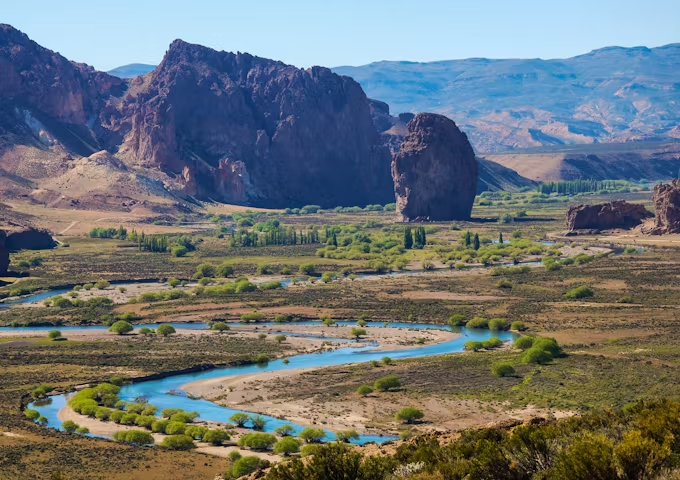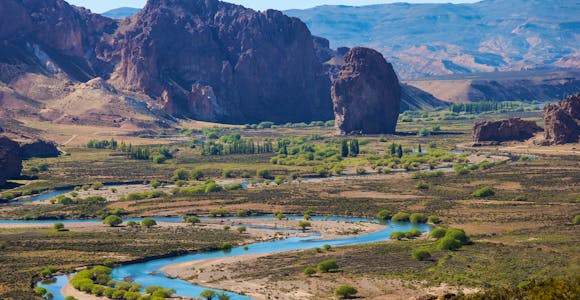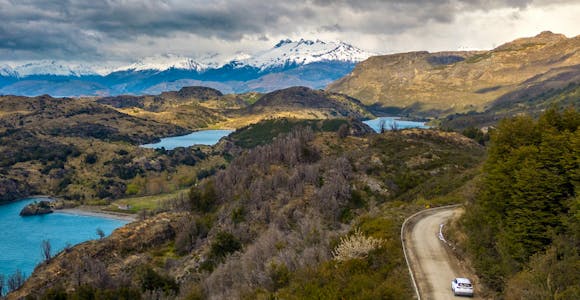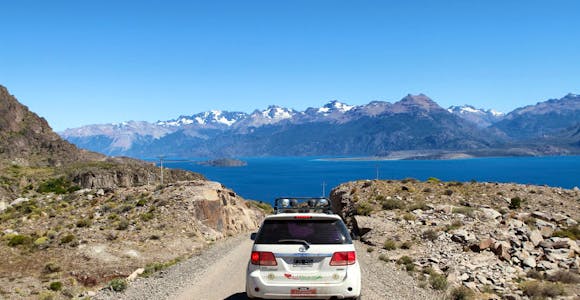
Cueva de las Manos
Named after its paintings of mainly hands, the Cueva de las Manos ('Cave of the Hands') hosts a perfectly preserved collection of cave art dating back 13,000 years. An …
Discover MoreDeep roots in Patagonia: We are ex-guides, tour leaders, outdoor enthusiasts, & adventurers.
We’ve got our feet on the ground: Impartial advice, a bespoke service, and at no extra cost.
For the ends of the Earth: Sustainability is more than our carbon footprint (but we’re reducing that too).

One of the longest highways in the world, travelling along the Ruta 40 is internationally renowned as a classic road trip. Beginning at the Bolivian border, it runs parallel to the Andes all the way to Rio Gallegos. The below focusses on the Patagonia stretch, at the heart of the route, between Bariloche and El Calafate.









.jpg?auto=format,enhance,compress&fit=crop&crop=entropy,faces,focalpoint&w=680&h=480&q=50)

Bariloche is the gateway to an extraordinarily diverse variety of landscapes from the jagged peaks of the high mountains, the open plains of the Patagonian steppe, the winding rivers filled with trout and different varieties of lush forest. There are high mountain refugios, historic estancias and lakeside luxury spa hotels.
The town itself is big and sprawling, it doesn't really sit on a beach and will get choca-block with tourists in the summer months. From the city centre, stretching out for more than 25kms along the lake shore, is a road which has pockets of hotels, lovely restaurants, beaches and stunning views out to the lake.

Vast waters and high peaks, Bariloche
Sitting under the imposing face of the Piltriquitron Mountain, El Bolson is a bustling little town, made famous in the 70s by people from Buenos Aires moving here to live a more alternative lifestyle.
During the summer months, it is still very popular with swarthes of Argentinian backpackers coming to enjoy the lifestyle, hiking trails and local micro-breweries. There are plenty of trails to explore and a collection of moutain refugios to be visited self-guided.

Los Alerces National Park, is an area of 2,630 square kilometres and is noted for its temperate rain forest (which is only present in 7 regions of the world), lakes, rivers, glaciers and marine fossils.
It also has the largest population of the Alerce tree in Argentina, one of the longest living trees on earth. This incredible environment supports a wide diversity of wildlife, including the Andean Condor, the puma, wild boar, mink, the elusive Huemul deer and, surprisingly, a native marsupial, the Colocolo Opossum.

Esquel is a bustling provincial capital of 40,000 people with tree lined streets, intriguing independent shops, cafes and restaurants. It is a lovely place to wander around of an afternoon, window shopping or people watching in the leafy main square. The town is also famous for La Tronchita, the narrow gauge railway which you can now travel 18 of the 402 kilometres of.
Drive 20 minutes from Esquel and you'll reach the charming little village of Trevelin. Here there is the Old Mill Museum, Welsh Chapels and the home of John Daniel Evans – a great hero of the Welsh settlement.

Los Antiguos is a charming small town of 5,000 situated on the shores of the Lago Buenos Aires (named Lago General Carrera in Chile). There are beautiful trees and irrigation channels running through the centre, as well as a plentiful fruit production – particularly cherries, being the national capital of the cherry. It is also the jumping off point for the Argentinian Patagonia Park, divided into three sections.

Although classically thought of as a self-drive route, there are many advantages to doing some parts or all of this route with a local guide. Not only will it make the whole landscape come to life, but it is also worth considering that these are very remote parts of Argentina and some backup is always prudent and helpful.
Sat in the spectacular Río de las Pinturas canyon carved out over thousands of years, the Cueva de las Manos, translating to Cave of the Hands, is a series of prehistoric caves containing paintings of (mainly) hands. The perfectly preserved paintings are the imprints of indigenous hunters who lived between 13,000 and 9,000 years ago, while there are also some paintings of traditional hunting scenes and native animals.
You can take a few different hiking routes around the canyon, observing the scenery and wildlife as you walk alongside condors. Cueva de las Manos is open every day of the year with guided tours offered, however, the nearest accommodation is in Los Antiguos, Gobernador Gregores, or Lago Posadas – there isn't any onsite.

Both the name of a sleepy little village and the immense lake home to the iconic limestone arch. Lago Posadas and its neighbouring Lago Pueyrredón are connected by an isthmus which is also the only access round to the estancias on the western shores of the lakes.
The lakes are surrounded by extensive salt flats with abandoned estancias at their shores, and volcanoes, lush plains and barren high passes showcase all sorts of colours – from blue, to purple, yellow and orange. Lago Posadas is also the starting/ending point of the lesser known, beautiful, Ruta 41, which is passable only by 4x4 and connects with Los Antriguos following the Andes.
.jpg?auto=format,enhance,compress&fit=crop&crop=entropy,faces,focalpoint&w=0&h=288&q=60)
Not to be confused with the Perito Moreno Glacier, 560 kms south in the Los Glaciares National Park, nor the mining town of the same infamous name 320 kms north, the Perito Moreno National Park has more than 200kms of newly laid trails and unmanned hiking refugios.
There is no public transport that services the park so it's very hard to get to without your own vehicle or on a private tour. The park houses endless turquoise glacial lakes, beautiful virgin beach forests and the soaring snow capped peaks of the Andes as a back drop.

Known as Lago San Martin in Argentina and Lago O'Higgins in Chile, this vast glacial lake spans the border of both countries. It is surrounded on one side by the imposing flat topped mesetas mountains and on the other by the snow capped Andes.
Estancias are dotted throughout the areas around the lake and spending some time here offers the opportunity to trek through the forests and uncover little-visited waterfalls and enchanted streams. You'll be in the company of woodpeckers, eagles and condors, and fishing enthusiasts will also be delighted by the salmon and trout that live in the pristine waters.

El Chalten is a small mountain village which is a famous launchpad for mountaineering expeditions, and well known for the wide selection of scenic day trails straight from the centre. It also has far more to offer; the rolling steppe can be explored by horse and bike, and the Rio de La Vueltas offers a water playground for kayaking and rafting.
Between activities, enjoy inspired local cuisine like the spicy mountain stew and sample locally-brewed pilsner and wine from across Argentina.
The biggest town in the area, a one or two-night stay in El Calafate is a great way to explore the Perito Moreno Glacier – whether you make your way around the walkways or choose the ice hike across the surface. In town, a modern museum details the history of the region’s many glaciers. Alongside various restaurants and bars, you'll find B&Bs, boutique hotels and hostels, while just outside of the city is a luxury lodge.
If you are planning to hire a car on this route then you will have to start in one of the main hubs, for example Bariloche or El Calafate – it isn't possible to pick up cars in smaller towns. If you plan to do parts of the route guided or visit just one part of the area, then consider taking the very reliable and comfortable public bus between hubs where your guide will meet you and take you out to see the very best of the region.
Great hubs towns to aim for are Esquel, Los Antiguos, Bariloche, El Calafate and El Chalten. Don't underestimate the distances between locations, they are large and even though the road is mostly paved, it is in quite a bad state in some places.

Once south of Esquel and north of El Calafate, the accommodation options aren't plentiful with many little villages just having one place to stay or there just being one farm within a sensible distance to the previous nights accommodation. Although few, the accommodation options on this route are charming, cosy and of a surprisingly good standard.

Either way you choose, travelling the Ruta 40 is an immense adventure witnessing Argentina's natural bounty. The decision will rest on your priorities. Do you seek the freedom to adapt your schedule as you go or are you eager to soak up the knowledge of a local guide? Do the long distances and remote locales excite you or would you rather focus on enjoying the sights while your driver keeps to schedule?
We'd love to understand what you're looking for, so that we can help you either rent a vehicle and plan your own itinerary, or organise a driver and guide, privately or as part of a group.
With not insignificant drop off fees in Patagonia, many people choose to do a loop combining both the Carretera Austral in Chile and the Ruta 40 in Argentina – this way you see a really diverse and contrasting landscape plus reduce the driving time and costs.
As with all road trips, it's important to define in advance which places you want to visit and how many miles you want to cover visiting these places.
If you're self-driving, we encourage you to factor in additional time – for any longer than expected parts of the drive, or any spontaneous stops to soak up the landscape or explore a local market.
Both roads have some stunning highlights along the way. The Ruta 40 is perhaps favoured for the surreal atmosphere. It is a seemingly endless open expanse of road; to travel these remote roads with no one or thing in sight and to experience the vastness of Argentina is profoundly special. In contrast, the Carretera Austral can be said to be both more varied and dramatic on an aesthetic level, with its huge landforms and glacial lakes.
If your plans allow for looping in/out of Chile/Argentina, we can help you arrange an itinerary which combines the highlights of both roads.
It’s paved the whole way between Bariloche and El Calafate, apart from a small section just south of Gobernador Gregores which can get flooded if it rains.

Named after its paintings of mainly hands, the Cueva de las Manos ('Cave of the Hands') hosts a perfectly preserved collection of cave art dating back 13,000 years. An …
Discover More
Another of the myriad surprises of the region, Welsh Patagonia is an area of the Lower Chubut Valley colonised in 1865. Today, roughly 20,000 of the estimated population of 150,000…
Discover More
Spanning the entire length of Aysen, this incredible highway passes through an endless parade of mountains, valleys, lakes and fjords, opening up the region for adventurous …
Discover More
Perhaps the best way, perhaps even the only way, to fully appreciate the vastness of the Patagonian wilderness is to go on a classic road trip. You, your friends, and …
Discover MorePatagonia offers an array of unique adventures catering for all variety of activities. At Swoop we pride ourselves on being adventure specialists whether that adventure be kayaking, mountain biking, horse riding, birdwatching, puma tracking, fishing, climbing, mountaineering or rafting.
We'll spend some time listening to your aspirations, then discuss the kind of experience that might suit you.
Next we'll discuss the options, shortlist the best trips for you and present you our impartial recommendations.
We'll place a 24 hour hold on your preferred option - without obligation - whilst we talk through the details.
Get in touch today to talk about your dreams for your trip.
Whether it’s a 2-week or 2-month adventure, you’re travelling independently or in a big group, you want to see Patagonia in comfort or discover challenging hikes, we’d love to help.
1 888 970 4571This website uses cookies to ensure you get the best experience on our website. Privacy policy